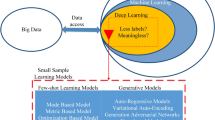Abstract
In recent years, artificial data became inevitable need for almost any of the deep learning applications. Most of the published works on data generation uses deep networks for signal generation without preprocessing and adequate characterization. Therefore, not properly summarizing data leads to dramatic loss of key aspects of the signal. In this study, we propose a generic way for creating signal that includes important features of the authentic data. Our approach involves time series clustering and Generative Adversarial Networks for grouping and simulating signals. Even with the very small amount of data, the model can effectively split data set into meaningful clusters and generates signals that have high monotonic associations to corresponding cluster. We finally report on experimental results of different time series clustering techniques used for preprocessing and the outcomes of different approaches are compared statistically for both synthetic and real data.
Access this chapter
Tax calculation will be finalised at checkout
Purchases are for personal use only
Similar content being viewed by others
References
Priemer, R.: Introductory signal processing. In: Advanced Series in Electrical and Computer Engineering. World Scientific Publishing Company (1990). https://books.google.com.tr/books?id=5AM8DQAAQBAJ
Liu, W., Wang, Z., Liu, X., Zeng, N., Liu, Y., Alsaadi, F.E.: A survey of deep neural network architectures and their applications. Neurocomputing 234, 11–26 (2017). https://doi.org/10.1016/j.neucom.2016.12.038
Nikolenko, S.I.: Introduction: the data problem. In: Synthetic Data for Deep Learning. SOIA, vol. 174, pp. 1–17. Springer, Cham (2021). https://doi.org/10.1007/978-3-030-75178-4_1
Esteban, C., Hyland, S.L., Rätsch, G.: Real-valued (medical) time series generation with recurrent conditional GANs (2017). https://doi.org/10.48550/ARXIV.1706.02633
Smith, K.E., Smith, A.O.: Conditional GAN for timeseries generation (2020). https://doi.org/10.48550/ARXIV.2006.16477
Goodfellow, I., et al.: Generative adversarial nets. Adv. Neural Inf. Process. Syst. 27
Mirza, M., Osindero, S.: Conditional generative adversarial nets (2014). https://doi.org/10.48550/ARXIV.1411.1784
Arjovsky, M., Chintala, S., Bottou, L.: Wasserstein GAN (2017). https://doi.org/10.48550/ARXIV.1701.07875
Theis, L., Oord, A.V.D., Bethge, M.: A note on the evaluation of generative models (2015). https://doi.org/10.48550/ARXIV.1511.01844
Harada, S., Hayashi, H., Uchida, S.: Biosignal generation and latent variable analysis with recurrent generative adversarial networks (2019). https://doi.org/10.48550/ARXIV.1905.07136
Brophy, E., Wang, Z., Ward, T.E.: Quick and easy time series generation with established image-based GANs (2019). https://doi.org/10.48550/ARXIV.1902.05624
Warren Liao, T.: Clustering of time series data-a survey. Pattern Recognit. 38(11), 1857–1874 (2005). https://doi.org/10.1016/j.patcog.2005.01.025
Kavitha, V., Punithavalli, M.: Clustering time series data stream - a literature survey (2010). https://doi.org/10.48550/ARXIV.1005.4270
Toft, P., et al.: On clustering of fMRI time series. NeuroImage 5
Goutte, C., Hansen, L., Liptrot, M., Rostrup, E.: Feature-space clustering for fMRI meta-analysis. Hum. Brain Mapp. 13, 165–83 (2001). https://doi.org/10.1002/hbm.1031
Petitjean, F., Ketterlin, A., Gançarski, P.: A global averaging method for dynamic time warping, with applications to clustering. Pattern Recognit. 44(3), 678–693 (2011). https://doi.org/10.1016/j.patcog.2010.09.013
Cuturi, M., Blondel, M.: Soft-DTW: a differentiable loss function for time-series (2017). https://doi.org/10.48550/ARXIV.1703.01541
Berndt, D.J., Clifford, J.: Using dynamic time warping to find patterns in time series. In: KDD Workshop, vol. 10, No. 16, pp. 359–370 (1994)
Li, D., Zhang, J., Zhang, Q., Wei, X.: Classification of ECG signals based on 1D convolution neural network. In: 2017 IEEE 19th International Conference on e-Health Networking, Applications and Services (Healthcom), pp. 1–6. IEEE (2017). https://doi.org/10.1109/HealthCom.2017.8210784
Goodfellow, I., Bengio, Y., Courville, A.: Sigmoid Units for Bernouilli Output Distributions. The MIT Press, Cambridge (2017)
Nair, V., Hinton, G.E.: Rectified linear units improve restricted Boltzmann machines. In: ICML, pp. 807–814 (2010). https://icml.cc/Conferences/2010/papers/432.pdf
Xu, B., Wang, N., Chen, T., Li, M.: Empirical evaluation of rectified activations in convolutional network (2015). https://doi.org/10.48550/ARXIV.1505.00853
Schober, P., Boer, C., Schwarte, L.: Correlation coefficients: appropriate use and interpretation. Anesth. Analg. 126, 1 (2018). https://doi.org/10.1213/ANE.0000000000002864
Kingma, D.P., Ba, J.: Adam: a method for stochastic optimization. arXiv preprint arXiv:1412.6980 (2014)
Author information
Authors and Affiliations
Corresponding author
Editor information
Editors and Affiliations
Rights and permissions
Copyright information
© 2023 The Author(s), under exclusive license to Springer Nature Switzerland AG
About this paper
Cite this paper
Ozturk, N., Günay, M. (2023). Synthetic Signal Generation Using Time Series Clustering and Conditional Generative Adversarial Network. In: Hemanth, D.J., Yigit, T., Kose, U., Guvenc, U. (eds) 4th International Conference on Artificial Intelligence and Applied Mathematics in Engineering. ICAIAME 2022. Engineering Cyber-Physical Systems and Critical Infrastructures, vol 7. Springer, Cham. https://doi.org/10.1007/978-3-031-31956-3_21
Download citation
DOI: https://doi.org/10.1007/978-3-031-31956-3_21
Published:
Publisher Name: Springer, Cham
Print ISBN: 978-3-031-31955-6
Online ISBN: 978-3-031-31956-3
eBook Packages: Intelligent Technologies and RoboticsIntelligent Technologies and Robotics (R0)




